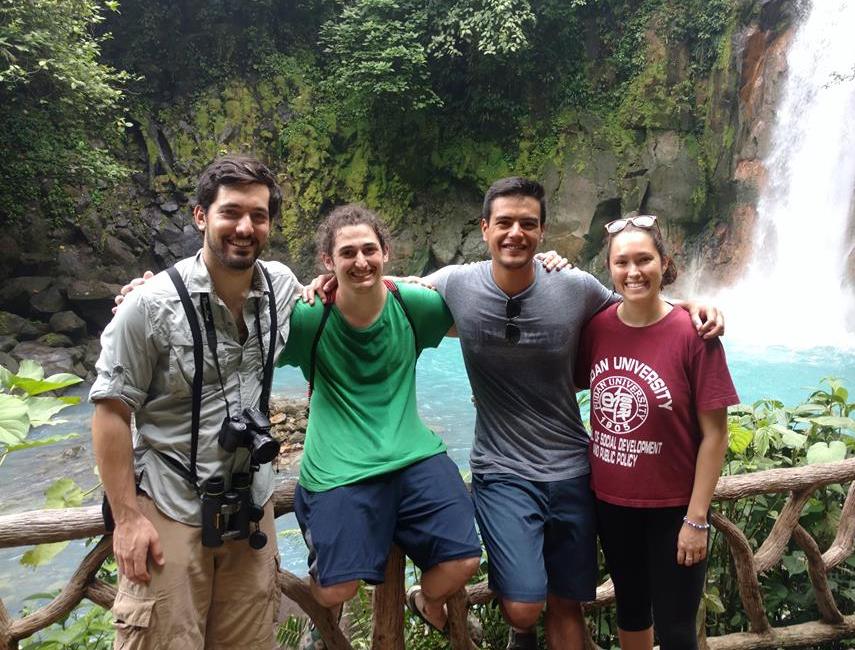Please join us in congratulating Seth Inman of Dunwoody, Georgia (left in above pic), winner of the March 2018 eBird Challenge, sponsored by Carl Zeiss Sports Optics. Seth’s name was drawn randomly from the 3,902 eBirders who submitted at least 15 eligible checklists in March with at least one rated photo or sound. Seth will receive a new ZEISS Conquest HD 8×42 binocular for his eBirding efforts. Here’s Seth’s birding story:
Although I grew up in Costa Rica and enjoyed seeing motmots in my backyard, or toucans on school trips, I wasn’t particularly fascinated with birds from a young age, but rather generally interested in all Tico––that is, Costa Rican––wildlife. But that changed in the last four or five years. I first heard of eBird through one of the Cornell Lab of Ornithology’s other citizen science projects called Celebrate Urban Birds. Since then I’ve been using
eBird.org and the eBird mobile app to document my observations all the time. What started more as a focus on making contributions to citizen science evolved over the last couple years into a full-fledged (pardon the pun) birding hobby, to the point where starting January 1st of this year I decided to commit to submitting at least one checklist a day in 2018 and see how that goes. I began making a conscious effort to try and complete the monthly challenges when possible back in 2015, never really believing that I would be randomly selected, but knowing that I was helping to provide whatever extra data the eBird team wanted to incentivize. Now I can enjoy an optics upgrade thanks to the generosity of Carl Zeiss Sports Optics and the eBird Team!
I strongly believe in the value of tapping into the huge global network of amateur experts that birders and birdwatchers form, so that we can add to the pool of knowledge on avian species created by trained ornithologists. But in addition to the scientific and statistical value of our checklists when added up to the millions of records, there’s also the personal benefits of eBird found in simply planning a birding trip by researching what kind of species have been seen where. I frequently use the Explore pages to find the best Hotspots to visit during my travels, and also enjoy creating a new Hotspot if I think a relatively unexplored area is worth highlighting for my peers. In particular I look forward to watching the Illustrated Checklist feature become more rich over time. Part of my work in conservation tourism has been helping hotels either form new Hotspots, or increase their dedication to consistently contributing data to their Hotspots, which creates a more valuable pool of information for the scientists analyzing eBird data, and also helps travelers decide where to go birding.

A Northern Mockingbird seen during one of my daily ten-minute neighborhood walks in March. Photo by Seth Inman/Macaulay Library.
Most of my March birding took place in the suburbs of Atlanta, GA, although I also finished up a trip to California’s Bay Area that yielded a fair number of new species for me, particularly certain grebes and the amusing American Avocet. Traveling is always exciting in its potential to see some fresh or completely novel birds, but I also had a fun “lifer” surprise in my own neck of the woods when a pair of migrating Sandhill Cranes flew overhead in Georgia. New species can pop up unexpectedly even on a
simple neighborhood walk! I like the monthly challenges––such as March’s––that encourage uploading photos to checklists, because I enjoy photographing birds anyway. Despite only having a point-and-shoot camera, every now and then a bird sits still long enough for me to get a shot I’m proud of and want to share. As it is I frequently use my camera to help me with tricky IDs; since I’ve only been birding for a handful of years and have moved between several countries while doing so, I still have lots to learn about local birds and their lookalikes. In this regard I’ve found the
Merlin app and
allaboutbirds.org webpage invaluable resources. I also appreciate the work of regional eBird reviewers who have double-checked certain sightings with me, in a couple cases leading to a different identification, and I welcome the corrections! There’s no doubt that using eBird has made me a better birder, so thanks to the whole team for providing a place for that to happen!

Birding in the tropics is a luxury, and I think this Black-and-yellow Silky-flycatcher at Poás Volcano in Costa Rica was the first truly crisp bird photo I ever got for such tough conditions, which makes this shot one of my favorites. Photo by Seth Inman/Macaulay Library




